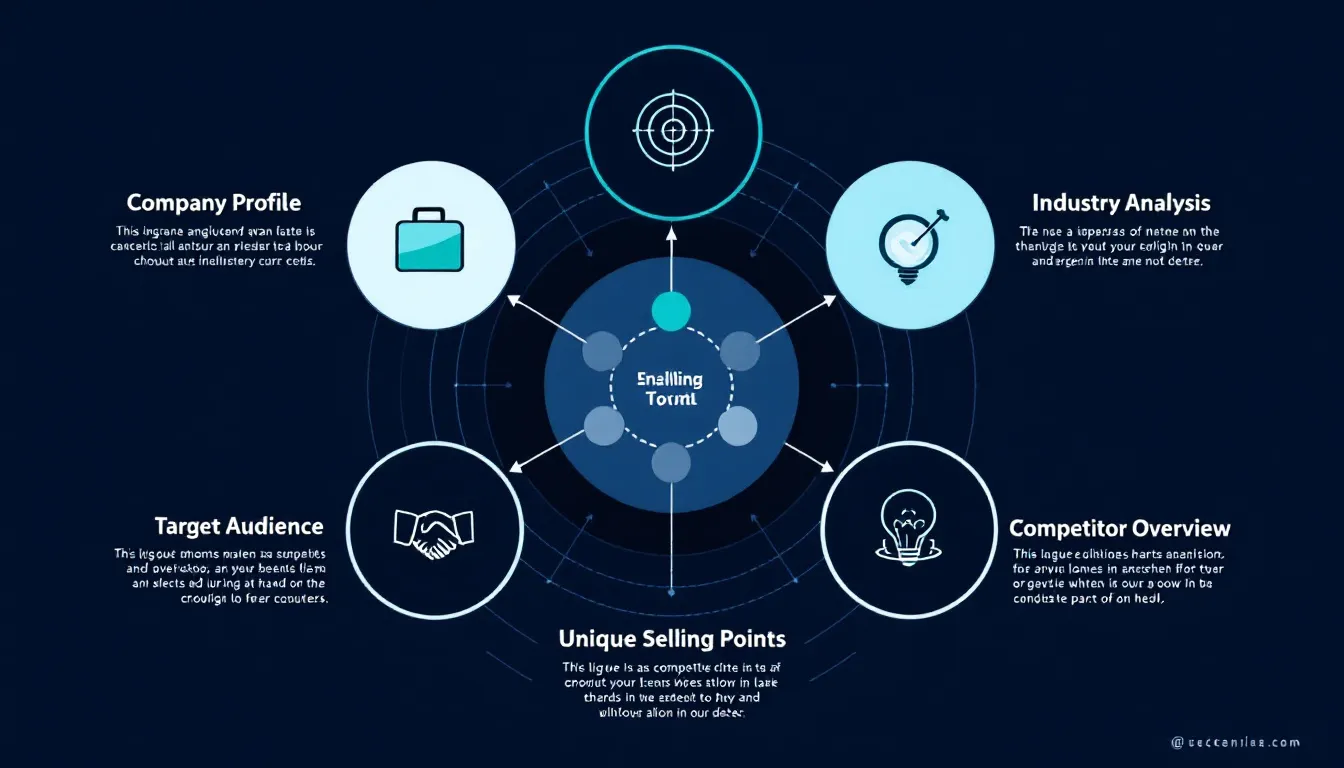Is this tool helpful?
How to Use the Competitive Analysis Tool Effectively
1. Company Name Input
Enter your business’s official name accurately to ensure the analysis aligns with your company’s identity. Examples you might use:
- Oceanview Health Partners
- NextGen Software Solutions
2. Industry Selection
Provide a precise description of your industry or business sector to tailor competitor comparisons effectively. Consider these examples:
- Renewable Energy Technology
- Mobile App Development
3. Target Audience Description
Define the key characteristics of your ideal customers, including demographics and preferences. Examples include:
- Young families seeking cost-effective home energy solutions
- Tech-savvy millennials focused on productivity apps
4. Competitor List
List your top three direct competitors, one per line, ensuring they compete in your market space. Sample entries might be:
- EcoVolt Solutions, GreenPower Inc, SolarWay
- AppCrafters, MobileMinds, CodeSprint
5. Unique Selling Points (Optional)
Highlight your distinct strengths or features that differentiate your business. Here are some examples to inspire you:
- 24/7 customer support with guaranteed response times
- Customizable app interfaces with multi-language support
About the Competitive Analysis Tool: Definition, Purpose, and Benefits
This competitive analysis tool provides a straightforward way to compare your business against your top competitors. It evaluates key aspects like market positioning, customer targeting, and unique selling points, helping you understand where you stand and identify opportunities to improve your competitive edge.
By analyzing information about your company and your main competitors, the tool generates actionable insights that support smarter business decisions. You benefit from clearer strategies for product development, marketing, and resource management through a structured evaluation process.
Key Benefits of the Tool
- Informed Strategic Planning: Helps focus on areas that improve your market position.
- Time-Saving Automation: Quickly distills competitor data into meaningful analysis.
- Opportunity Identification: Reveals underserved customer segments and gaps in market offerings.
Practical Usage of the Competitive Analysis Tool
You use this tool by filling out a form with information about your company, industry, target customers, competitive landscape, and optionally, your unique selling points. Once submitted, the tool processes this data to produce an analysis highlighting your strengths, competitive advantages, and areas for growth.
For example, an e-commerce business may discover that competitors offer slower shipping options, prompting them to improve their logistics. A professional services firm might identify niches that competitors haven’t addressed, helping them tailor new offerings.
Use Case Examples
- Software Startup: Identifies unique features lacking in competitors’ products, helping target development resources efficiently.
- Local Restaurant Chain: Highlights competitors’ gaps in menu variety, inspiring menu innovation.
Key Elements of Effective Competitive Analysis
Market Positioning Evaluation
Assess how your brand compares in customer perception and industry standing versus competitors.
Competitor Strengths and Weaknesses
Identify where competitors excel and where they fall short to target your improvements strategically.
Audience Alignment
Understand overlap in customer bases and recognize underserved groups you can engage.
Unique Value Proposition
Clarify what makes your business different to better highlight those advantages in your marketing and product development.
Maximizing Insights: From Analysis to Action
Strategic Action Steps
- Identify priority areas for improvement and innovation.
- Develop targeted response plans to competitive challenges.
- Create timelines for rolling out changes.
- Allocate resources effectively to meet goals.
Ongoing Monitoring and Improvement
Regularly update your competitive analysis to stay ahead, track industry changes, and adjust your strategies to maintain a strong market position.
Frequently Asked Questions About Competitive Analysis
How often should you conduct competitive analysis?
Perform competitive reviews quarterly or more often if you operate in fast-paced industries. Frequent analysis helps you react to market shifts quickly.
Can you analyze more than three competitors?
This tool focuses on your top three competitors to deliver clear insights. To cover more companies, submit multiple analyses and aggregate the results for a comprehensive overview.
How do you identify your main competitors?
Look for businesses that:
- Target similar customers
- Offer comparable products or services
- Compete in your geographic area or market niche
- Have overlapping marketing channels or sales tactics
What makes an effective unique selling point?
An effective USP is:
- Clearly different from competitors’ offerings
- Valuable and relevant to your target audience
- Sustainable over time and defensible
- Authentic to your brand’s identity and mission
How can you best use the analysis results?
Share the insights with your team and integrate them into your strategic plans. Use the findings to guide product improvements, marketing campaigns, and resource decisions. Update your strategies as market conditions evolve.
Is this tool suitable for niche or unique industries?
Yes. By describing your specific market and competition, the tool adapts its analysis to provide relevant insights regardless of industry.
Important Disclaimer
The calculations, results, and content provided by our tools are not guaranteed to be accurate, complete, or reliable. Users are responsible for verifying and interpreting the results. Our content and tools may contain errors, biases, or inconsistencies. Do not enter personal data, sensitive information, or personally identifiable information in our web forms or tools. Such data entry violates our terms of service and may result in unauthorized disclosure to third parties. We reserve the right to save inputs and outputs from our tools for the purposes of error debugging, bias identification, and performance improvement. External companies providing AI models used in our tools may also save and process data in accordance with their own policies. By using our tools, you consent to this data collection and processing. We reserve the right to limit the usage of our tools based on current usability factors.







